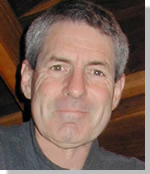 On The Road
On The Road
by: Bill Oetinger 11/1/2009
French Toast
If you read my column last month, you know I spent most of September cycling and sightseeing in the South of France. I predicted last month that I might be revisiting that visit in future columns, and that begins with this one, which amounts to some rambling, mildly incoherent observations on what I saw while I was there.
I did the same after my last Euro-bike vacation, in Italy and Switzerland, a few years back. I wrote three columns about that trip: one about European drivers, one about some of the big ascents we did--those famous Giro passes--and one that was a catch-all of impressions about what we experienced. This column falls into that last category.
As I did in at least one of those prior columns, I have to begin with the standard disclaimer for a topic such as this: any impressions I may have absorbed during the adventure were accumulated in a very short time span and in a very small corner of France: Eastern Provence and the Southern Alps. After this brief exposure, I can no more claim to have a handle on all of France than someone who did a bike tour in Northern California and then claimed to have experienced all of the United States. If I end up generalizing from the particular, you are advised to take anything I say with a large grain of salt.
Provence and the Rhone Alps add up to a delightful region. It's the sort of place--like Tuscany or Napa-Sonoma--where people come, to visit or to live, because it is idyllic or close to it. (You don't see dreamy bestsellers called A Year in Kansas or Under the Tulsa Sun.) Those who are fortunate enough to live there full time have it pretty good, whether they're well-to-do or salt of the earth. Those who have the wherewithal to visit arrive with some heightened level of privilege and comfort...those happy tourists, among whom I must count myself. We of course chose to ride and stay in pleasant places. No surprise there. And this region is about as pleasant as they come.
All of that tilts my perspective about what I experienced. No ghettos, no trash, no congestion, no faceless suburban sprawl. Just beautiful scenery, quaint villages, and small, livable cities. Nothing to do each day but ride the bike on world-class roads, admire the scenery, eat good food and drink good wine. So that's my disclaimer: I was looking at a lovely world through the rose-colored glasses of a very happy cycle-tourist.
A road-biking tourist spends a lot of time on the road. It's pretty much one's all-day, everyday job, being out there, rolling along. So a lot of my impressions have to do with what goes on out on those French roads. I have to say I was favorably impressed on several levels.
First of all, there are all the attractions that are of immediate, obvious interest to a cyclist: the lore of the Tour de France or the Dauphiné or other classic races. We get all excited when the pro peloton rides our Sonoma County roads in the Tour of California, but there, in France...geez, they've been racing on those roads for over a century. Every rider who ever did anything of note did a lot of it on those very roads we were riding. Hallowed ground. On the most famous, most iconic climbs, you see the graffiti on the pavement, exhorting this hero or that favorite son to deeds of grandeur and glory. If you have any interest in the legends and history of racing, it feels special to be there.
Part of what makes it feel special is that you can easily see the way the general populace embraces the racing as something significant. It's not some esoteric, poorly understood niche sport. It's mainstream and prime time. Everywhere you turn you see evidence of the respect accorded to bike racing. It might be a monument to Fausto Coppi alongside the Col d'Izoard, or it might be a polka-dot plywood cow on the side of the road on Col de la Croix de Fer. Or a poster signed by Sean Kelly in a hotel lobby. All of that is exciting, but the best part of it is that it translates as respect and even honor for all cyclists on the roads, even if one is clearly just a fat old tourist and not a card-carrying pro. Drivers treat you with courtesy and patience; old men and school kids wave and call out, "Allez, allez!" as you pedal past. People lean out the windows of passing cars to shout encouragement (instead of hassling you). I even noticed people checking me out to size up my form. They look you over with a discerning eye. They've watched a lot of races, maybe been in a few, and they understand what they're seeing.
So that's all fun. Then there are the roads themselves, and the country through which they wind their way. I may or may not write another column about the famous cols we climbed. We hit quite a few big-name summits, plus a lot of obscure ones. We also explored well away from the famous venues, off on little roads through breathtakingly scenic gorges and canyons. I would have to work overtime to come up with the adjectives to describe how spectacular it all is. You know I'm a tireless promoter of the cycling merits of Sonoma County and the North Bay, but oh my... we've got nothing on the southeastern corner of France. We hardly had a dud mile in all of the ones we rode, and most of them were as far from dud as you can get. Jaw-droppingly, eye-poppingly amazing.
But that's a topic for another day, I think. It's a huge topic, and of course the scenic charms of the region were one of the primary reasons we spent all that money and made all that effort to be there. So yes, someday I may wax poetic or rhapsodic about all of that. But that's the obvious stuff. Today I'm thinking about some of the less obvious stuff.
For instance, the quality of the road system: paving, bridges, tunnels...everything under the heading of infrastructure. We did find some bad pavement. Col de Sarenne, up above Alpe du Huez, is rough. But that goes with the territory. It's so remote and so primitive, it almost needs to have sketchy pavement to complete the experience of a real walk on the wild side. But overall the paving is well above average by US standards. It's off-the-chart better than Sonoma County. You might worry about flying over a cliff and plunging into a gorge, but you don't have to worry about pinch-flatting in a pothole.
But pavement is only one aspect of the road system, and perhaps its most humble (although most essential) component. Also of interest are the larger structures one encounters: bridges and tunnels and those ubiquitous roundabouts we see the riders flowing around in the Tour de France. I was very impressed by all aspects of road infrastructure in France.
• Bridges
 We saw and crossed many bridges that were very old--hundreds of years old in some cases--but still in service and doing their job, and looking very attractive while doing it. We also encountered some newer spans that clearly show the French engineers have not lost their knack for impressive design and execution. These newer bridges reminded me of the articles I read a few years back about the Millau Viaduct, an enormous bridge completed in 2004. (It's a bit west of where we were riding, but still in the south of France.) I recall reading at the time that the bridge--as huge and magnificent as it is--was finished ahead of schedule and under budget. (I see now--looking it up on the 'net--that they did not meet their firstdeadline because of setbacks due to bad weather, but they did finish ahead of the revised schedule that was in place after the weather delays.)
We saw and crossed many bridges that were very old--hundreds of years old in some cases--but still in service and doing their job, and looking very attractive while doing it. We also encountered some newer spans that clearly show the French engineers have not lost their knack for impressive design and execution. These newer bridges reminded me of the articles I read a few years back about the Millau Viaduct, an enormous bridge completed in 2004. (It's a bit west of where we were riding, but still in the south of France.) I recall reading at the time that the bridge--as huge and magnificent as it is--was finished ahead of schedule and under budget. (I see now--looking it up on the 'net--that they did not meet their firstdeadline because of setbacks due to bad weather, but they did finish ahead of the revised schedule that was in place after the weather delays.) 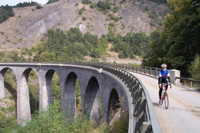 It's a grand, majestic structure, the longest and highest bridge in the world, and very handsome.
It's a grand, majestic structure, the longest and highest bridge in the world, and very handsome.When I read about it and see how impressive it is, and how they brought it in on time and on budget (more or less), I can't help but compare that project with the painfully slow, limping-along progress on the Oakland Bay Bridge: way behind schedule and way over budget and a long way from being done. And now--as I write this--the whole bridge is shut down because some of their retrofits are failing. Or the interstate bridge in Minneapolis that simply collapsed because its materials were substandard. What do the French engineers know that our engineers don't?
• Tunnels
 I started wishing, on about our third stage, that I had kept a count of all the tunnels we rode through on this tour. Some days, we rode through at least a dozen. Then add in all the dramatic natural arches we rode under, and those spots where a road is carved into a notch in the cliff face, with the native stone overhead...sort of half a tunnel. These subterranean passages came in all shapes and sizes. Some were rather ordinary and some were anything but.
I started wishing, on about our third stage, that I had kept a count of all the tunnels we rode through on this tour. Some days, we rode through at least a dozen. Then add in all the dramatic natural arches we rode under, and those spots where a road is carved into a notch in the cliff face, with the native stone overhead...sort of half a tunnel. These subterranean passages came in all shapes and sizes. Some were rather ordinary and some were anything but. Take the Tunnels de Fayet in the Grand Canyon of Verdon: carved into the sheer cliff, with a series of windows cut into the rock so you can peer out at the vast gorge spilling away below. This reminded me of the long tunnel in Zion National Park in Utah, which has similar windows cut into the rock. The big difference between the two? In Verdon, you can
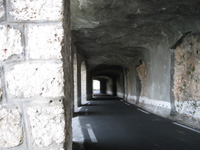 ride your bike through the tunnel; in Zion, bikes are prohibited in the tunnel. In the Tunnels de Fayet, you can stop, walk around inside, take pictures (all of which I did). In Zion, no dice. Ixnay. No exceptions. You have to put your bike in a car to go through the tunnel. If you don't have a car at your disposal, you simply have to wait until someone comes along who will give you a lift. Ridiculous.
ride your bike through the tunnel; in Zion, bikes are prohibited in the tunnel. In the Tunnels de Fayet, you can stop, walk around inside, take pictures (all of which I did). In Zion, no dice. Ixnay. No exceptions. You have to put your bike in a car to go through the tunnel. If you don't have a car at your disposal, you simply have to wait until someone comes along who will give you a lift. Ridiculous. You get the feeling that the French authorities are not nearly as worried about needing to protect us from ourselves as the folks in charge in Utah. We rode through dozens of primitive, dramatic tunnels and also out along the rims of sheercliffs with only the most minimal railings between us and the void. No one told us we couldn't or walled us off from the potentialdanger. There were usually signs posted warning of the danger, but that was it. It seems the French just don't have that same fear of liability litigation that has everyone covering their keesters over here. Either that or they simply feel the general public is a lot smarter and more responisble than we do here.
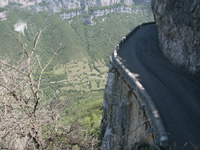 I don't want to overstate this, so for counterpoint I will note that we were shut out of part of our ride through one of these dramatic, cliff-hanging roads--the Gorges de la Bourne--because there had been some rock slides on the road that had killed some people, so they were in the process of rebuilding the road...taming it to make it a little less edgy and a little bit safer. And they finally got fed up with the rock falls on another spectacular slot-canyon road, the Grands Goulets, and closed it permanently, alas. And while we were there, yet another famous slot canyon road, Gorges du Cian, was closed at least for the time being because of rock falls. (We rode through anyway.) So yes, they are responsible and prudent. But in general, you see a lot more leeway being granted to the road users. They seem to be saying: proceed at your own risk; we know this cliff-hanging road can be dangerous, but we give you, the road user, the benefit of the doubt. We assume you know what you're doing and will behave appropriately. Over here, we more frequently seem to assume the worst about people: that if they can do something really stupid, they probably will. We tailor our response to that potential lowest common denominator, rather than asking people to rise to a higher standard of competence and prudence.
I don't want to overstate this, so for counterpoint I will note that we were shut out of part of our ride through one of these dramatic, cliff-hanging roads--the Gorges de la Bourne--because there had been some rock slides on the road that had killed some people, so they were in the process of rebuilding the road...taming it to make it a little less edgy and a little bit safer. And they finally got fed up with the rock falls on another spectacular slot-canyon road, the Grands Goulets, and closed it permanently, alas. And while we were there, yet another famous slot canyon road, Gorges du Cian, was closed at least for the time being because of rock falls. (We rode through anyway.) So yes, they are responsible and prudent. But in general, you see a lot more leeway being granted to the road users. They seem to be saying: proceed at your own risk; we know this cliff-hanging road can be dangerous, but we give you, the road user, the benefit of the doubt. We assume you know what you're doing and will behave appropriately. Over here, we more frequently seem to assume the worst about people: that if they can do something really stupid, they probably will. We tailor our response to that potential lowest common denominator, rather than asking people to rise to a higher standard of competence and prudence.• Roundabouts
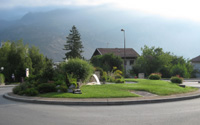 Put quite simply, they work. I don't know when the first modern roundabouts went into service in Europe, but I can remember loads of them from when I lived in England and traveled in France in the 1960's. They've had a long time to get used to them. Watching drivers negotiate them is almost a thing of beauty, the traffic flows so smoothly. I had a hotel room on the 4th floor overlooking the busiest intersection in the small city of Briançon, with four roads and a big parking lot flowing into it, and with crosswalks all around the perimeter handling loads of foot traffic. During a few idle moments, I stood at the window and watched the never-ending flow of traffic through that roundabout. Although the volume of both vehicles and pedestrians was very heavy, it never backed up. It always kept moving. And no one ever got bent out of shape. Folks cooperated with one another...waited their turns. No drama, no trauma.
Put quite simply, they work. I don't know when the first modern roundabouts went into service in Europe, but I can remember loads of them from when I lived in England and traveled in France in the 1960's. They've had a long time to get used to them. Watching drivers negotiate them is almost a thing of beauty, the traffic flows so smoothly. I had a hotel room on the 4th floor overlooking the busiest intersection in the small city of Briançon, with four roads and a big parking lot flowing into it, and with crosswalks all around the perimeter handling loads of foot traffic. During a few idle moments, I stood at the window and watched the never-ending flow of traffic through that roundabout. Although the volume of both vehicles and pedestrians was very heavy, it never backed up. It always kept moving. And no one ever got bent out of shape. Folks cooperated with one another...waited their turns. No drama, no trauma.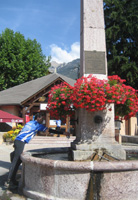 We saw it when we rode through them on our bikes as well: we were part of the traffic flow, accepted pieces in the puzzle. I never once heard a horn honked in anger in any of the roundabouts we encountered. This has as much to do with the attitudes of the drivers as it does with the roundabouts, but the two are parts of the same story: the roundabouts work because the drivers come to them with the right mindset; and the drivers have good attitudes (at least in part) because the roundabouts are well designed and work efficiently.
We saw it when we rode through them on our bikes as well: we were part of the traffic flow, accepted pieces in the puzzle. I never once heard a horn honked in anger in any of the roundabouts we encountered. This has as much to do with the attitudes of the drivers as it does with the roundabouts, but the two are parts of the same story: the roundabouts work because the drivers come to them with the right mindset; and the drivers have good attitudes (at least in part) because the roundabouts are well designed and work efficiently.We're beginning to see their implementation in this country, but it has been an uphill struggle to convince people of their efficacy and efficiency. One was proposed for the end of my own street--in the normally progressive town of Sebastopol--and from the protests and horror coming from nearby neighbors, you would have thought that simple little traffic circle was the nephew of the Great Satan. The planners put the proposal back on the shelf, and that conventional, old-school intersection at the end of my street is still a pain in the ass.
One other note about roundabouts: occassionally they're just plain bare circles, but more frequently they serve as settings for attractive landscaping or public art. Small towns and bigger cities all seem to take pride in dressing up these traffic islands. The same thing is true of the ubiquitous public fountains in the centers of all the older town centers (where we always stopped to fill our bottles): almost always prettied up with flowers or artwork. Little touches like these seem well beyond the basic package of maintenance that any municipality would deem appropriate for standard services, but we saw them everywhere, and they add up to a subtle quality-of-life enhancement for everyone.
• Cars
One more observation about the roads, but it's a big one: the vehicles on the roads. I'm a car nut as well as a bike nut, and I paid close attention to all the cars and trucks with whom we were sharing the roads. I can tell you it bears only the thinnest resemblance to the traffic mix we see here. First of all, all of the vehicles are smaller. What a fascinating range of small cars and micro-minivans they have over there! My four-door Honda Civic would be above-average for size on the roads of France. There is an almost total absence of enormous SUV battle cruisers--Expeditions, Yukons, Hummers--nor any of our ubiquitous monster pick-ups. Over the course of our tour, I counted a grand total of one full-size American pick-up and around half a dozen mid-size SUVs. How refreshing! Can you imagine a traffic mix devoid of SUVs? Yes indeed.What interested me especially is how many of the cars on the road there we don't see here. Many of the Euro manufacturers apparently have no need of the US market to be successful. Renault, Peugeot, Citroen, Fiat, Seat, Skoda, and several more, all doing variations on the theme of small, peppy sports coupes...fast, nimble, and thrifty with the diesel. About the only cars we saw there that we also see here were the German brands and a scattering of Japanese cars.
All of those small, maneuverable cars added up to a reasonably bike-friendly environment. The drivers could make quick, clean passes on narrow roads. Every US cyclist who rides in Europe comes away with this same impression: bikes are not just tolerated; they are accepted and accommodated as equal partners in the traffic mix...an authentic sharing of the road. When a driver passes a cyclist, you get the feeling there is an unspoken communication between them that might go something like this: "I'm a good driver and you're a good rider. We both know what we're doing and we both understand one another." No confusion. No mixed signals. No angst. And certainly no hostility or grievance. What a revelation: that it could be this way!
But enough about roads and cars and infrastructure.
What about that famous French cuisine? After we returned, when people would ask me how my trip had been, I found myself talking about the food quite often. It's such a cliché that it makes an easy, one or two-sentence response to such questions. I guess we all take it for a given that the food is going to be good. It was, although I would not say it was all sublime. Some was fairly ordinary. But let me begin with an anecdote about our first real French meal of the trip...
After some dreadful delays in our flights to France, we arrived well after dinnertime one evening and collapsed into bed, exhausted. We had our continental breakfast at the hotel the next morning and then hopped right on the bikes for our first ride. (I don't count that hotel breakfast as a true example of Frence cuisine, even though the croissants were very good.) We rode that first day up into the rocky hill country of Haut Provence, climbing most of 5000' before we decided to break for lunch. By that time we were hot, tired, and starving. I was with my two pals Robin and Gordon, and as the tour leader, I assured them we would find something to eat in the next town up the road, the little village of Saint Auban.
When we saw the village, I think our hearts sank a little. We were down on the valley floor and the hillside village was another half-mile up a steep lane, with no obvious promise of any food available if we rode up there. But then we spied one little cafe right down at our level...a little brasserie. It looked funky from the outside and not any better on the inside, and it came complete with the standard array of old farts on the front porch, fumigating the place with their vile cigarettes and cigars. Decor was cracked linoleum, old formica tables, girly calendars, and a pinball machine. It did not look promising. What's more, the proprietor informed us that he was through serving lunch for the day. (We didn't know that most places quit serving lunch at two pm, and it was now almost three.) But we looked so crestfallen at the prospect of no food that he took pity on us and said he would throw together some ham and cheese salads for us ("jambon et chevril")...would that do? We said, fine...whatever. We couldn't afford to be choosy.
In a similar establishment in this country, I would expect a pile of shredded iceberg lettuce, some strips of Kraft Singles and chunks of Hormel ham, with maybe some ranch dressing. But not in Provence. In a few minutes, he served up three platters that could have been, should have been photographed for a feature in Gourmet magazine. (Sorry...we forgot to take any photos.) The crisp, leafy greens--assorted lettuces and their near neighbors--were all just picked in his garden out back, lightly dressed with a subtle vinaigrette. The ham, arrayed in strips atop the greens, consisted of several paper-thin slices of the tastiest ham I've ever eaten--a bit like prosciuto but leaner. On top of this, four slices of fresh baguette, lightly toasted, with a round of soft, delicious goat cheese melted over each one. Everything, from greens to cheese, was clearly fresh and of local origin. Everything was perfect, both visually appealing and delightful in texture and taste. This is fast food from a funky greasy spoon? Wow! Welcome to France.
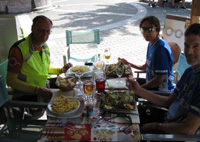 We had similar experiences on other days when we stopped for lunch. (I'll include a photo from another of those days.) One of my favorite memories of lunch is of a day that was otherwise not at all a favorite of mine. That was because we were riding in the rain and were borderline miserable. Five of us stopped at this little cafe in the village of Clelles. We walked in and saw that there were patrons at every table in the place. Not every table was full, but all were occupied by at least a couple, and all of them appeared to be local. The owner took one look at these five soggy, bedraggled cyclists and went into action. First she asked some of her locals if they would mind doubling up at one table to free up a table for us. She spoke not a word of English, but she found a customer who did, and this lady came over and told us the owner was very sorry, but she only had three helpings of the day's special left (roast beef). We said that's okay; just put all the roast in one big bowl and bring us five plates. Plus, bring us another big bowl of pomme frites...french fries. And five cups of café au chocolat. On a cold, wet day, that hearty, melt-in-your-mouth roast beef and those crisp fries were just what we needed.
We had similar experiences on other days when we stopped for lunch. (I'll include a photo from another of those days.) One of my favorite memories of lunch is of a day that was otherwise not at all a favorite of mine. That was because we were riding in the rain and were borderline miserable. Five of us stopped at this little cafe in the village of Clelles. We walked in and saw that there were patrons at every table in the place. Not every table was full, but all were occupied by at least a couple, and all of them appeared to be local. The owner took one look at these five soggy, bedraggled cyclists and went into action. First she asked some of her locals if they would mind doubling up at one table to free up a table for us. She spoke not a word of English, but she found a customer who did, and this lady came over and told us the owner was very sorry, but she only had three helpings of the day's special left (roast beef). We said that's okay; just put all the roast in one big bowl and bring us five plates. Plus, bring us another big bowl of pomme frites...french fries. And five cups of café au chocolat. On a cold, wet day, that hearty, melt-in-your-mouth roast beef and those crisp fries were just what we needed.Most of our hotels were taken on the demi-pension plan, meaning dinner and breakfast were included in the room rate. This is a good deal usually, assuming the hotel also runs a decent restaurant. The one possible drawback is that you usually don't get to choose your meals: you eat whatever they're serving as their house special of the day. But seeing as how we wouldn't have known much about what to order if we had been given the chance to do so, it was just as well that we let the staff serve us their specialities.
These hotel meals varied from slightly better than average to absolutely sensational. I mentioned in my summary last month a marathon gastronomic extravaganza we enjoyed at the Hotel de la Poste in the village of Corps. This was the one evening when our demi-pension arrangement allowed for some menu choices: probably a half-dozen options each for the first and second courses. Everything from baked trout to game pie to spit-roasted lamb to wild boar. Then there was a line on the menu: Assorted Starters...unspecified. We expected bowls of olives and little pickles and we got that, but we also got at least three other full courses of starters, including sampler platters of scallops, mussels, crayfish, oysters on the half-shell, and salmon baked in a flakey pastry crust. Plus wonderful salads. Plus fresh-baked bread. Plus more platters of every sort of appetizer you could think of. We'd had a full meal by the time our first course arrived. By the time we'd finally dispensed with an assortment of decadent desserts, we were basket cases. But very happy basket cases. I had booked that hotel because of an on-line review that had raved about the cooking...the absolute best Provençal cuisine the reviewer had ever encountered. I expected it to be good, but the reality was so far beyond my expectations...and all at a quite reasonable price.
No other dinner really came close to that one, but several were very, very nice. The Hotel du Commerce in Castellane and the Hotel de la Chaussée in Briançon were both delightful, and we were at each of them for two nights. The Hotel l'Ours Blanc in Allos introduced us to raclette...a variation on fondue, with cheeses melted over heaters on the table and drizzled over potatoes and baguettes. This was a hearty pick-me-up after our other grim day of riding in the rain.
Okay...I have to wrap this up. I've gone on too long already and yet have hardly scratched the surface of all the things I'd love to write about. Were I to continue, I expect much of what I would say would sound a lot like what I wrote about our tour in Italy. If you're interested, you can read those columns and extrapolate from them for France. In spite of their language differences and some cultural variety, the two regions have more in common than otherwise, and we were within a few miles of the Italian border on several occasions. Both regions are famous for their great cuisine, their stunning scenery, their (usually) pleasant weather, their friendly, welcoming people, and--of course--for their wonderful cycling roads, replete with the heritage of the Tour and Giro.
I'd like to sum this up with one thought. It's a notion some of us were talking about while we were in France. All of us were impressed with how well France seems to function, at least in the pleasant regions we visited. The roads and traffic systems work. The villages and cities appear clean and well-organized and efficient, not to mention charming and attractive. Generalizing broadly here, the people appear to be sensible and courteous and functional as they go about their lives. Nothing struck us as being out-of-balance or dysfunctional. Add to that a couple of news items I picked up while there: the savings rate for French households is about 20% of income (while in the US, it is an appalling minus 1%); the French health care system is rated the best in the world (while the US system is rated thirty-seventh). All in all, it looks like a society that is getting it right, most of the time.
There is a tendency among some Americans to break their arms patting themselves on the back, loudly proclaiming far and wide that the US of A is the greatest nation on earth. No question, America is a wonderful country, one I am very proud to call my own. But that doesn't mean I'm blind to her faults. One of the benefits of traveling abroad is seeing how other folks live; how they organize their societies. Having just spent awhile in France, I am faced with the sobering thought that we may not be the only folks who can figure out how to get things done, and in fact others may be doing a better job of it than we are right now. Rather than telling everyone else how great we are, we might do ourselves and the rest of the world a favor if we looked around at how some other countries are managing things. We might learn something useful.
Bill can be reached at srccride@sonic.net

